Domestic rifle grenades
At about the same time as the Gobyato mortar, a similar weapon system appeared, which allowed attacking enemy positions at smaller distances. It was in Port Arthur that Russian soldiers first used shotgun rifle (rifle) grenades. This weapon had an extremely simple design, but, nevertheless, surpassed the existing grenades in characteristics. The ramrod grenade was made of a hand grenade and a metal rod, for example, a ramrod. Such ammunition was launched from the Mosin rifle barrel and could fly over a distance of more than 50 meters. Even the most experienced fighters could not throw a hand grenade at such a distance. However, at the end of the war, the shompol grenades were temporarily forgotten.
This interesting and promising weaponry was remembered only before the First World War. Russian military leaders received information on the creation and use of rifle grenades in foreign countries. The General Staff showed some interest in these systems, but did not initiate their development. According to some information, before the outbreak of the war, the command was engaged in another matter: who should be responsible for the creation of rifle grenades, the engineering or artillery department. As a result of this, Russia entered the First World War without gun grenades.
The outbreak of war forced military leaders to change their minds. The military department announced a competition for the creation of rifle grenades, and by the winter of 1914, several projects of such weapons were ready. A member of the Commission on the application of explosives guard colonel V.I. Rdultovsky, officer of the Military Automotive School V.A. Mgebrov, Colonel 4 of the Zelensky reserve engineer battalion, as well as the technician A.A. Karnaukhov, electrician S.P. Pavlovsky and the engineer VB Segal
Schompolnaya grenade arr. 1915
Shompolnaya grenade V.I. Rdultovsky soon received the designation “a rifle grenade arr. 1915 of the Year. Being developed in the shortest possible time, this munition was extremely simple, which had a positive effect on the possible production rates. The basis of the Rdultovsky grenade was a cast-iron case of a slightly elongated shape. There were threaded holes in its upper and bottom parts. The bottom hole was designed for cork with ramrod. On the ramrod there was a brass obturator, which protected the barrel from the ramrod steel and prevented the breakthrough of powder gases. A shock fuse was screwed into another hole of the grenade, the design of which was based on previous similar designs. For safe handling before the shot, the fuse must have a check.
The total weight of the Rdultovsky grenade was 615 grams, the weight of the charge was 130 g. During the explosion, the cast-iron body was divided approximately into 300 fragments. At an elevation angle of 45 °, the firing range reached 220 steps. However, the new grenade had some drawbacks. Expensive brass was needed to make some important parts, and water could get into the fuse through the hole for the checks. Despite the shortcomings, the simple-milled grenade was adopted for service.
It should be noted that a new modification of the grenade was created later. 1915 of the year, the design of which took into account all the shortcomings of the first version of ammunition. After modernization, the grenade retained only the ramrod with the obturator. She received a new cylindrical body with conical head and tail parts. Updated grenade received a new fuse tubular shape. In the fuse there was a hammer with a long sting. The sting was put on the tube, in the end of which was located primer. In the stowed position, the tube was held by a check, and besides it rested against a spring. When hit the target tube, moving by inertia, had to hit the cap on the sting of the striker. The check and spring reliably protected the shooter from an accidental explosion. In addition, the design of the updated grenades arr. 1915 of the year did not allow ammunition to explode to the target. Before hitting the target, the cap was located in a special cavity in the tail of the grenade and could not initiate an explosion of the main charge.
Grenade arr. 1915, the second model, turned out to be lighter than its predecessor: its curb weight was reduced to 550. The explosive charge had to be reduced to 30. The number of fragments was reduced to two hundred. Despite the loss in basic characteristics, a new grenade when fired at an elevation angle of 45 ° allowed targets to be hit at distances up to 250-260 steps (according to other data, up to 300 steps). In addition, the upgraded ammunition was much safer and safer to handle.
Both grenades of the Rdultovsky design should have been launched with a Mosin rifle. For aiming, it was necessary to use a sight of a simple construction, which was a goniometer, the marking of which was carried out not in degrees, but in steps. A grenade should be fired using an idle cartridge with a powder charge of no more than 3 grams. The use of live ammunition was strictly forbidden: the rifle could be the easiest consequence of such a shot, and besides, a grenade explosion was not ruled out. When firing a rifle had to rest against the ground with the butt.
Shompolnaya grenade V.A. Mgebrova
Of great interest is the milling grenade built by Captain Mgebrov. In his project, this officer applied several original ideas, some of which, in a sense, were ahead of their time. Unfortunately, V.A. Mgebrov was unable to continue the development of his grenade. In the 1915 year, during a trip to the front for testing grenades, the captain took command of a company that had just lost its commander. During the attack, Mgebrov was seriously injured and died during the operation. Nevertheless, he managed to dictate some information about the tests of a grenade.
The grenade of the construction of Mgebrov had a streamlined body in which the fuse and the main charge were located. An interesting feature of the grenade was a hollow ramrod. Inside the ramrod it was proposed to place the powder pulp, which, according to modern terminology, made the grenade active-reactive. The additional charge inside the ramrod should have significantly increased the range of the grenade.
The head of the grenade caliber 40 mm and length 146 mm contained a charge of explosive (tetryl or a mixture of tetryl with TNT) and the central fuse tube. Mgebrov applied an interesting system that protected the grenade from a premature explosion. As on the Rdultovsky second version grenade, there was a firing pin with a long sting mounted on the Mgebrov grenade, attached to the ammunition head. To explode a grenade, a special spring-loaded tube with a primer should have moved onto the firing pin. During the shot and at the beginning of the flight, the tube was additionally held by the low-melting part. After the powder burned out inside the ramrod, the fire should have been transmitted to the thermite piece at the bottom of the grenade. The checker was designed to melt the holding part. After its destruction, the tube with the cap was held only by a pair of levers. When the target hit the target, it moved forward by inertia and the striker hit the primer.
Grenade weighing 480 g contained in itself 80 g of explosive. At an elevation angle of 45 °, the firing range reached 400 steps. With the explosion of a grenade gave up 200 fragments. To launch a grenade, it was necessary to use a blank cartridge with a gram of gunpowder 2,9. The author of the project proposed to use a new grenade not only to defeat enemy personnel in the trenches, but also against armored vehicles. In practice, such an application of the grenade was not tested, but it was not excluded. In addition, some sources mention the possibility of firing the Mgebrova grenade not from the ground, but from the shoulder.
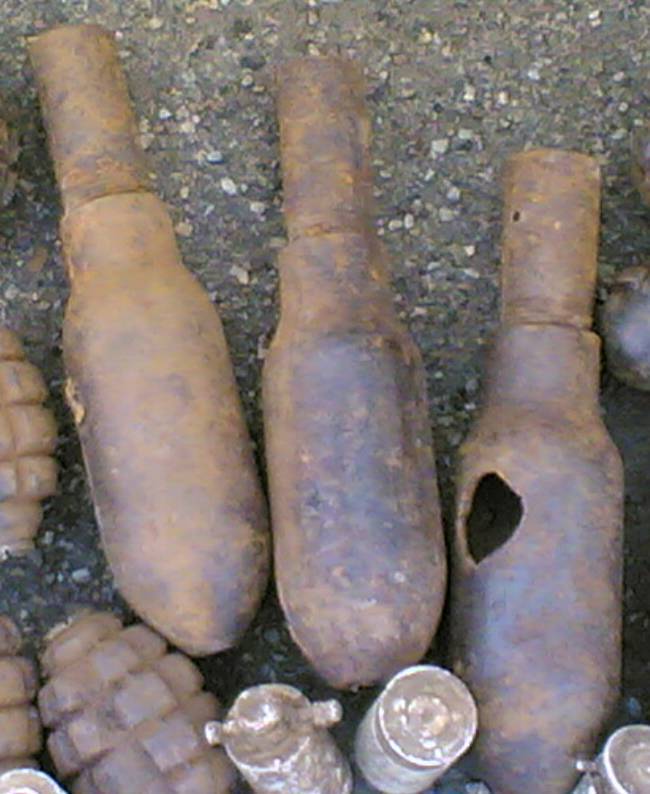
The grenade Mgebrova had both advantages and disadvantages. The first can be attributed to the greater range and safety of use, and the main disadvantage of the munition was the relative complexity of the design. In addition, the grenade with powdery pulp in the cleaning rod should be protected from moisture, which in the trench was quite difficult.
Schompolnaya grenade Zelensky
Colonel Zelensky had some experience in creating gun grenades - the first such ammunition of his design was created during the Russo-Japanese War. In the future, Zelensky continued to improve his grenade and by the end of 1914, he presented a new model, devoid of the drawbacks of the previous one.
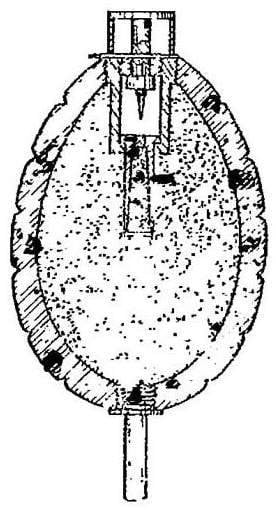 Cast iron body grenades Zelensky arr. The 1914 of the year was ovoid with two holes. In the upper hole with the thread was supposed to screw washer-weighting, designed to stabilize the grenades in flight. The puck had a large outer diameter, which, according to the author of the grenade, was supposed to eliminate the rebound in the fall. The fuse of the original design should be screwed into the bottom hole. In the bottom of the fuse there was a hole for fixing the ramrod. To protect the barrel on the ramrod there were several brass rings.
Cast iron body grenades Zelensky arr. The 1914 of the year was ovoid with two holes. In the upper hole with the thread was supposed to screw washer-weighting, designed to stabilize the grenades in flight. The puck had a large outer diameter, which, according to the author of the grenade, was supposed to eliminate the rebound in the fall. The fuse of the original design should be screwed into the bottom hole. In the bottom of the fuse there was a hole for fixing the ramrod. To protect the barrel on the ramrod there were several brass rings.Almost the entire internal volume of the grenade was occupied by an explosive charge. In the middle and tail parts of the body, in the center, there was a tubular fuse. The shock inertial detonator consisted of an idle chuck “Nagan”, in which it was placed a capsule with 2 grams of explosive mercury, a massive drummer, and a safety spring. During transportation, the drummer was fixed in the extreme rear position by check. When a grenade hit a target, the massive inertia drummer had to compress the spring and move forward, impaling the primer of the idle cartridge. Powder charge cartridge and primer with explosive mercury initiated the detonation of the main charge.
When using idle rifle cartridge with a charge of 2,9 g of gunpowder, the firing range of the Zelensky grenade reached the 250 steps. It is noteworthy that the grenade of Colonel Zelensky was the heaviest created in 1914 year - its full weight reached 900 g. The mass of the main charge (ammonal) - 40 g.
Muzzle mortar of Karnaukhov, Pavlovsky and Segal
Technician A.A. Karnaukhov, electrician S.P. Pavlovsky and the engineer VB Segal did not begin to work on the next shompolnogo grenade, but proposed to arm the infantry with muzzle muzzles. A small mortar should have been mounted on the Mosin rifle barrel and used a special grenade. It was expected that such a weapon would have a greater firing range in comparison with other grenades.
Mortirka Karnaukhov, Pavlovsky and Segal had a caliber of 16 lines (40,6 mm) and a barrel about 28 in length. Mortika was asked to be mounted on the barrel of a rifle like a bayonet. The shot was to be made with the help of a blank cartridge with 2 g of gunpowder. Muzzle mortar used a grenade of the staff of the captain MG Dyakonov, equipped with a remote tube. A cylindrical grenade with a conical head had a cast-iron body, inside of which there was an explosive charge. At the bottom of the grenade there was a remote tube, which allowed the grenade to be undermined for 10 seconds after the shot. Ready to fire a grenade weighed 540 g, explosive charge - 81,7 g. When exploded, the cast-iron case of the Dyakonov grenade was crushed into 500 fragments. The firing range of the mortars of Karnaukhov, Pavlovsky and Segal reached 450 steps.
In addition, the proposed ammunition designed by Dyakonov. An 236-gram lighting grenade could fly on 500 steps.
On the fronts of the First World War
Tests of all the presented grenades presented their characteristics and importance for the infantry. In the spring of 1915, the Main Artillery Directorate, which by that time had become responsible for the creation of rifle grenades, placed orders for the production of new ammunition. It was necessary to supply 500 thousand grenades of the Rdultovsky first model, 400 thousand grenades of Zelensky, 15 thousand grenades of Mgebrov and 2000 of muzzle mortars of Karnaukhov, Pavlovsky and Segal with 100 thousand grenades of Dyakonov. Due to the large load of state-owned factories, the Main Artillery Directorate had to place orders at private enterprises. At the same time, however, equipment ammunition explosives left behind state-owned factories.
Unfortunately, the Russian industry was not able to fulfill the order of the Main Artillery Directorate. Thus, in the first eight months of 1917, 44 thousand grenades of the Rdultovsky first version went to the front, less than 7900 Mgebrov grenades and only 40 muzzle muzzles with 18 thousand grenades. Due to the low rates of production, the troops constantly lacked muzzle grenades, which accordingly affected their capabilities. It should be noted that the production of hand grenades of all existing systems was conducted at a stable rate - every month the troops received about one million of such products.
It is known that in the absence or inadequate number of serial grenades, soldiers at the front created their own handicraft designs. The use of rifle grenades, hastily converted from hand-held ones, slightly increased the infantry's firepower, but still could not have a significant impact on the course of the battles.
Grenade launcher MG Dyakonova
The lack of own-made rifle grenades led to the emergence of proposals for the purchase of such ammunition of foreign development. However, in the summer of 1917, the military came to the conclusion that the proposed French grenades have no advantage over the system proposed by captain MG G. Dyakonov. It should be noted that the testing of Dyakonov’s development began in the spring of 1916, however, two years after that, the promising rifle grenades did not get into the troops.
Dyakonov proposed to arm the infantry with muzzle loops with the appropriate ammunition. Mortar itself was a rifled barrel caliber 41 mm, with a special tube mounted on a Mosin rifle. For aiming, the mortar gun was equipped with a quadrant sight. With the help of a plumb line and marks on the sight it was possible to direct a rifle with a mortar with the desired angle of elevation.
A grenade for a new grenade launcher could be launched using live ammunition. For this purpose, in the ammunition of caliber 41 mm and length 112 mm there was a through central tube with a diameter of about 7,8 mm. It was assumed that when fired using live ammunition a bullet would pass through this tube. The central tube was screwed into the gray cast iron body. On the outer surface of the body had square incisions, due to which during the explosion, it was crushed into 450-500 fragments. Like the previous development of Dyakonov, the new grenade was equipped with a remote tube. The gunpowder pressed in the tube had to be set on fire by the powder gases of the rifle cartridge. The tail of the grenade with a hole in the distance tube for transportation was closed with a removable cap. The grenade Dyakonov weighed 256 g and had a charge of 50 g. The firing range at the optimum elevation angle exceeded the 400 steps.
In December, the 1916 of the year, the MG grenade launcher. Dyakonov was tested on the South-Western Front. Front Commander, General A.A. Brusilov approved a new weapon and demanded to put in the troops entrusted to him 600 thousands of similar grenades. Taking into account other fronts, 40 thousand Dyakonov grenade launchers and 6125 thousand grenades were ordered for them. The whole 1917 year was spent on solving various production issues, which is why before the start of 1918, the military never received a single serial rifle grenade of the new system. Finally, 1 March 1918, all work was discontinued due to the declared demobilization of the industry.
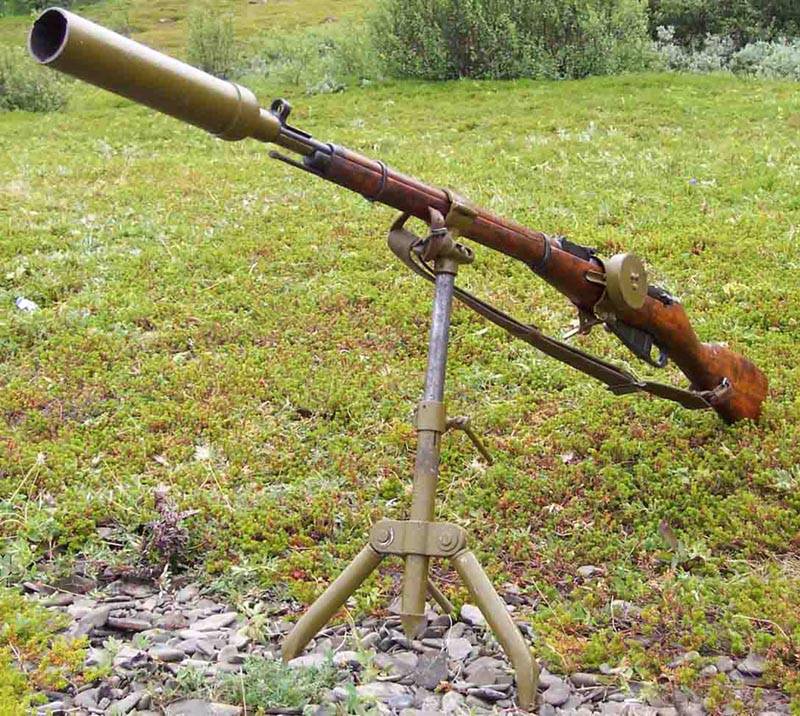
Dyakonov's rifle grenade launcher, left view
For several years Dyakonov’s grenade launcher was forgotten, but his story continued in the late twenties. In 1927, a new quadrant sight appeared, designed for pointing a grenade launcher in a vertical plane. The design of the new sight had little difference from the base model, and all the improvements related to production technology. In 1930, a new sight, modified for use with a Mosin rifle, arr. 1891 / 30's. In particular, now the sight was attached to the rifle with a collar with a wing nut. The last redesign of the sight took place in 1937 year. As a result of the refinement, the quadrant was placed on the rifle's box, next to the standard sight. From the end of the twenties, the Dyakonov grenade launcher was attached with a folding bipod and a small plate for placing the butt in soft ground.
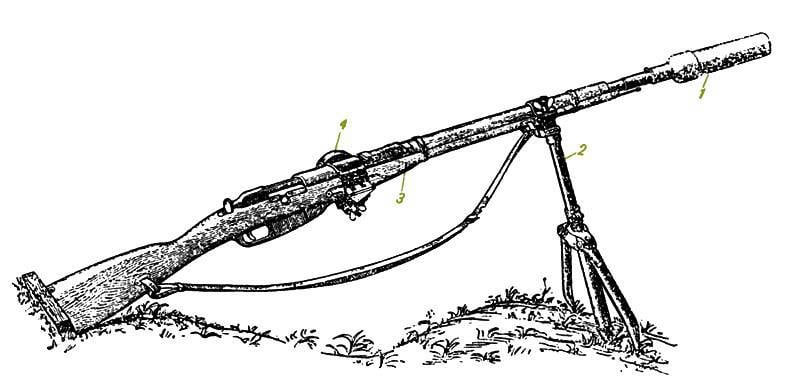
General view of the Dyakonov rifle grenade launcher: 1 - mortar; 2 - fry; 3 - rifle; 4 - quad protractor
In the late thirties, the active development of armored vehicles led to the emergence of a new ammunition for the Dyakonov grenade launcher. The VKG-40 grenade (“1940 rifle cumulative grenade of the year”) had a streamlined body and an explosive charge with a characteristic notch in the head section. In the tail of the grenade there was a shock fuse of inertial action. When hitting the target, the massive drummer was supposed to ignite the primer, and he, in turn, initiated the detonation of a shaped charge and the formation of a gas jet.
For shooting grenade VKG-40 used blank cartridge with a gram of gunpowder 2,75. The reduced charge, if necessary, allowed a grenade to be fired with a butt stop in the shoulder. For aiming it was possible to use the standard Mosin rifle sight. The “16” mark in this case corresponded to a shot at 50 meters, and “20” - at 150 meters.
VPGS-41
In 1941, the Soviet gunsmith engineers returned to the idea of a ramrod grenade. With all its advantages, Dyakonov’s grenade launcher had serious drawbacks: a large weight (rifle with a bipod, a mortar and a sight weighed about 8 kg), the impossibility of firing a bullet without removing the mortar, and increased wear of the barrel due to greater gas pressure than when firing a bullet. The grenade grenade, in turn, did not require any additional devices, and could also be used by any shooters, not just grenade throwers.
Serdyuk VGPS-41 anti-tank rifle grenade was created in the design bureau of the People's Commissariat of the coal industry. In the fall of the 41st, the ammunition was tested, and on October 13 it was put into service. The new design grenade was intended for rifle units and was supposed to improve their ability to combat tanks the enemy. In the summer and autumn of 1941, the infantry was in dire need of effective anti-tank weapons.
Grenade VGPS-41 consisted of five nodes: the head, the percussion mechanism, the fuse, ramrod and stabilizer. The head of the grenade was a cylindrical part with a diameter of 60 mm and a length of 115 mm. The tail of this node had a conical shape. The trotyl charge (334 g) with a hemispherical recess in the head part, lined with a thin layer of metal, was placed in the metal case of the head part. The impact mechanism of the grenade was made according to the inertial scheme, its main element was a movable massive drummer. This part was held by a spring and was fixed by a check. A ramrod with a diameter of 7,5 mm was screwed into the tail end of the percussion mechanism. In front of the ramrod, a mobile stabilizer was attached.
Grenade weight 680 g sent to the target with a single rifle cartridge. The original feature of the VGPS-41 grenade was a mobile stabilizer, which increased shooting accuracy. During transportation and preparation for firing, the stabilizer was in front of the ramrod. During the shot, the inertia stabilizer moved to the tail of the ramrod and stopped there. Due to this mutual position of the heavy head of the grenade and stabilizer, the accuracy of firing in comparison with unstabilized grenades has increased markedly. When shooting at a single target, it was recommended to fire at a distance of about 50-60 meters. When attacking a cluster of vehicles, acceptable accuracy was achieved at ranges up to 140 m.
During serial production, the VGPS-41 anti-tank grenade was repeatedly developed in accordance with the capabilities of defense enterprises. Because of this, the ammunition of different plants and different time of release may differ significantly from each other. It is known that Serdyuk's grenades were produced until the spring of 1942. According to some sources, Stalingrad factories manufactured these grenades until the middle of that 42. Subsequently, the production of grenades ceased due to ambiguous combat characteristics.
***
The manufacture and use of all domestic rifle grenades was completed in the 1943-44 years. This weapon had insufficient characteristics and did not meet a number of requirements of the time. The rifle grenades had a relatively short range of shot and insufficient power. In terms of their characteristics, they were superior to hand grenades, but significantly inferior to mortars and light field artillery. It should be noted that the use of rifle grenades was seriously complicated by the lengthy preparation for the shot, and this imposed certain restrictions on shooting in combat conditions.
The rifle grenades were discontinued and their use gradually ceased. Nevertheless, the idea of light infantry weapons, capable of throwing a grenade for several tens of meters, did not die. A few decades after the end of World War II, it led to the emergence of rifle-mounted grenade launchers. This weapon met all the requirements for the range of fire and the power of the ammunition, and, unlike rifle grenades and mortars, did not prevent the use of small arms for its intended purpose.
On the materials of the sites:
http://otvaga2004.ru/
http://army.armor.kiev.ua/
http://ww1.milua.org/
http://weapon.at.ua/
http://calibr.ucoz.ru/
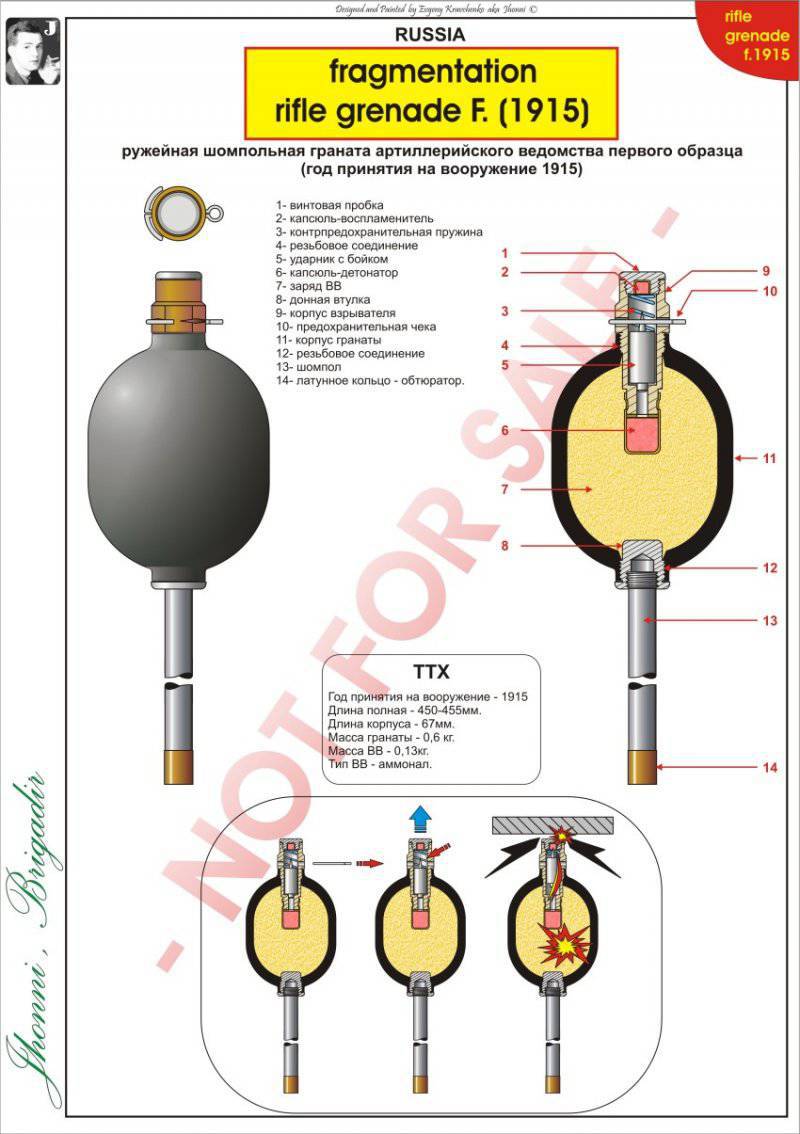
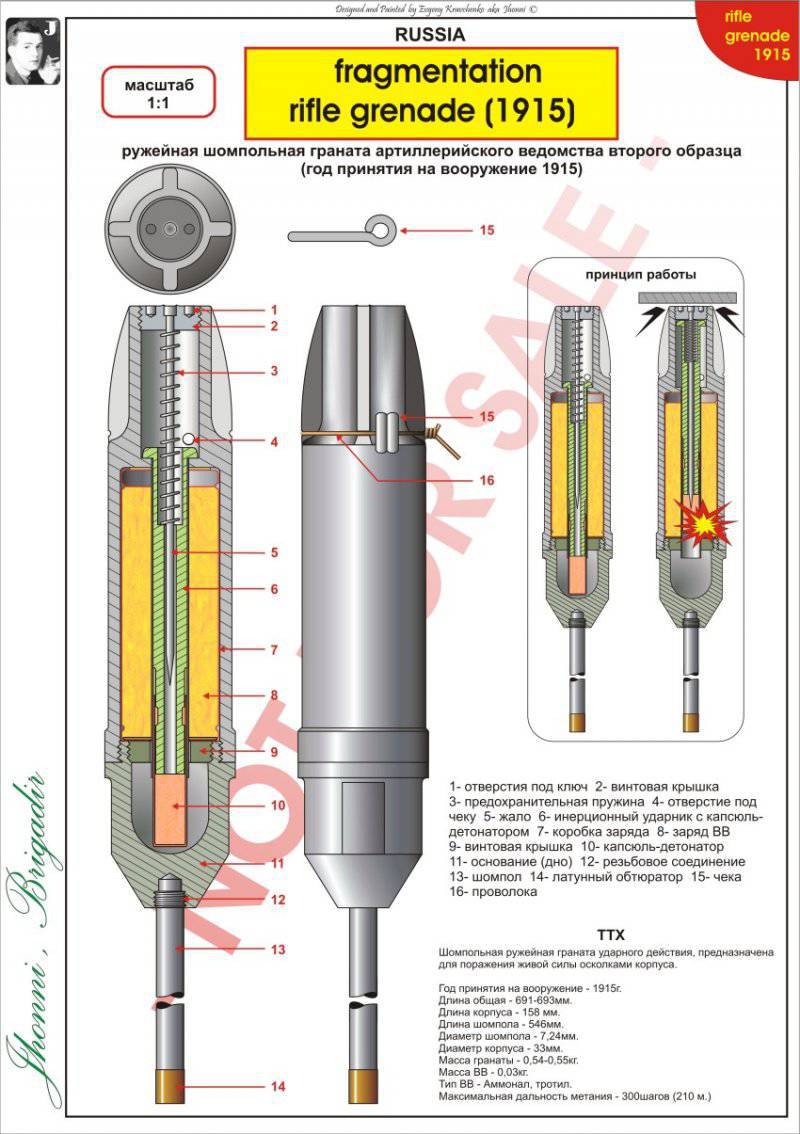
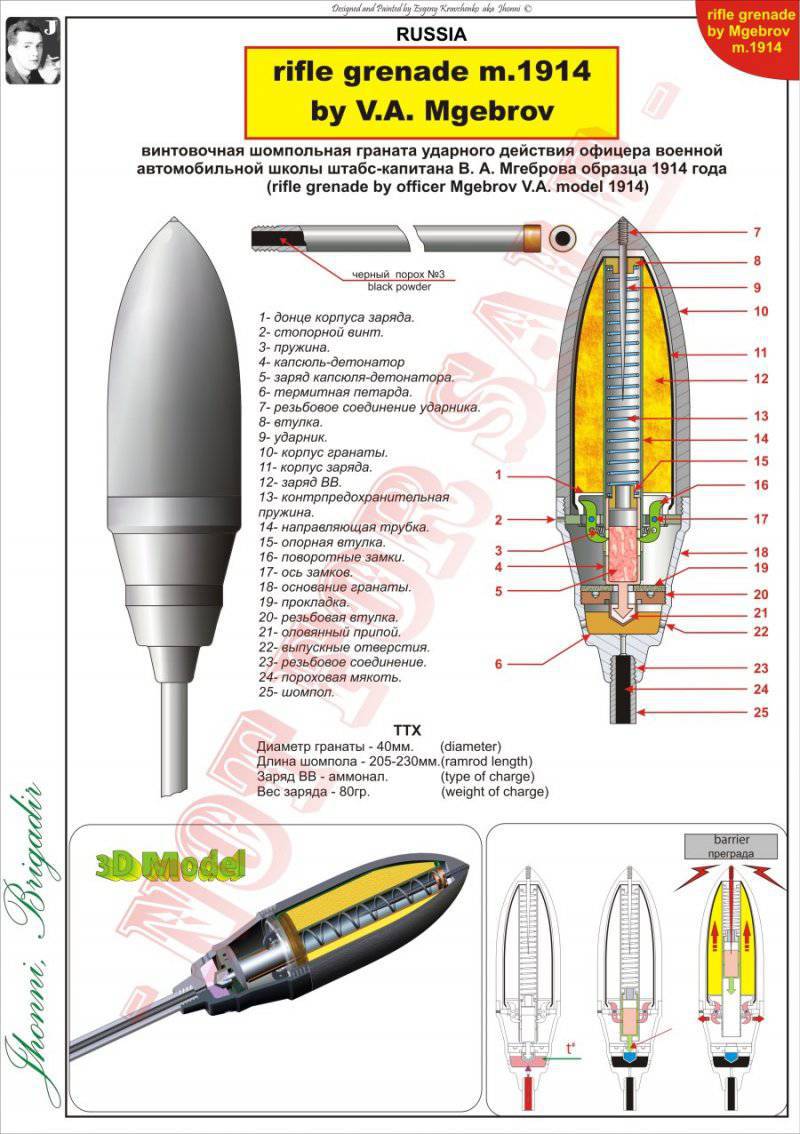
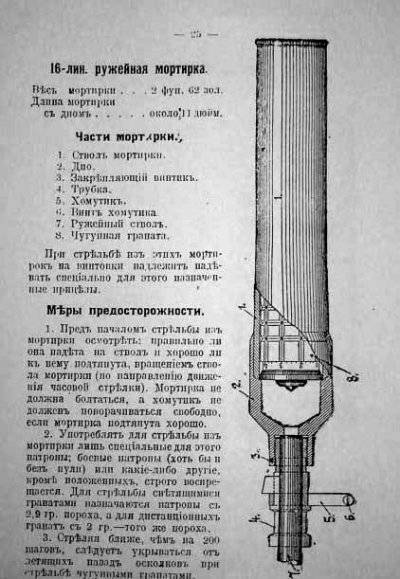
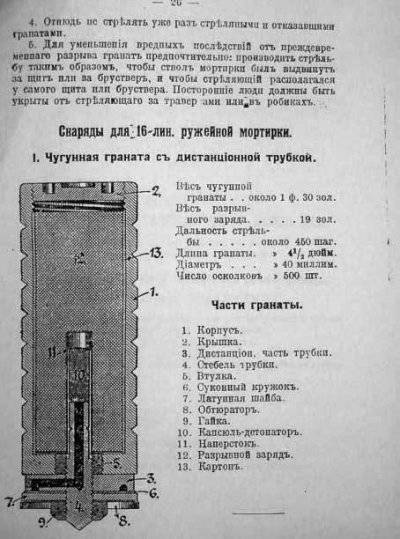
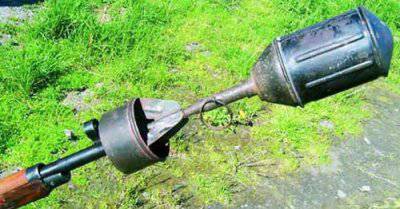
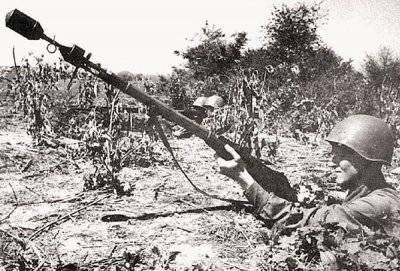
Information